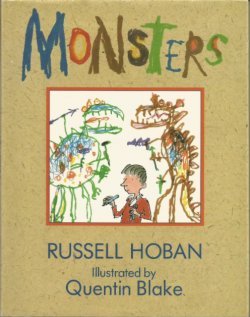Gareth B. Matthews

Review of Monsters by Russell Hoban (New York: Scholastic, 1990). Originally published in Thinking: The Journal of Philosophy for Children 9(3): 1.
John liked to draw monsters – all kinds of monsters. Some of them looked like puddings with teeth. Some had hundreds of eyes, and odd numbers of ears. Some were funny, some were scaly, some were green, some, purple. But all, all of them were violent. John’s monsters breathed smoke and fire, they used guided missiles, lasers, bow and arrows, spears, clubs, and rocks.
John’s mother suggested he must be tired of drawing monsters. She wondered why he didn’t draw houses and trees and birds and animals.
“Monsters are animals;” John replied simply.
“I mean real animals, like dogs and cats;” said his mother.
“Monsters are real;” was the reply. John’s mother asked whether John had ever seen a monster.
“On TV,” he said.
“But walking around?”
“Not yet:”
John’s father asked about school. “Getting on with the other boys and all that?” he asked.
John said he was having no trouble. Then he got his mother to give him a huge piece of wrapping paper on which he drew the tail of a monster. He said he needed a bigger piece, so that he could draw the rest of it.
John’s parents approached the art teacher about John’s preoccupation with monsters. The teacher found nothing wrong with John, or his monsters. The parents went to Dr. Plunger, who wrote out a prescription for John. But when the monster drawings persisted, Dr. Plunger allowed as how he had better have a chat with John. And he did.
While John was in the office with Dr. Plunger, John’s father and mother waited nervously outside. They heard loud noises coming from the doctor’s office. After a while John emerged, smiling.
“Will you be seeing Dr. Plunger again?” John’s mother wanted to know.
“I don’t think so;” said John.
“No more monster drawings?” asked John’s mother.
“Who needs drawings?” replied John. As he spoke one could see that what looked like an enormous monster had filled Dr. Plunger’s office.
What is real? The houses, trees, birds, and animals one child draws? Or the monsters, ghosts, and dragons pictured by another? Most parents and teachers, like John’s mother in this story, think the answer is obvious. They are comfortable with the familiarly “primitive” depictions of “real” things in child art. But a child who insists on drawing monsters unnerves them.
Of course, it isn’t really that only houses, trees, and birds will do. Dinosaurs are usually quite acceptable within limits. Santa Claus and the Easter Bunny are positively reassuring. So are characters from Sesame Street, and now Ninja Turtles.
No doubt it is the violence of John’s monsters that most worries his parents. Those monsters “fought with passing strangers and random spacecraft:’ They fought with each other. And, when alone, they “made threatening noises to themselves while waiting for somebody ugly to turn up:”
We adults are bothered about the violence in our society, and with good reason. We want to think our children are innocent of it and protected from it. But then a child is shot on a city street or even in school! And TV is so full of violence.
John, in the story, is a remarkably composed and well-adjusted child. Perhaps, like the player-goer Aristotle portrays in his Poetics, John finds a healthy catharsis in the terrible events of the artistic imagination. More like Plato’s Socrates in Book X of the Republic, John’s parents seem to think that the violence of art should simply be done away with.
What do the children in your family, or classroom, think? This provocatively funny and wisely ironic story gives us all a chance to join that ancient debate. Alas! We cannot eliminate the violence from our society, or entirely protect our children from it but we can discuss its role in our lives and our imaginations. We can discuss that role even with our children – or better, especially with our children.
